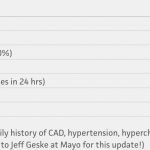
The requirement to wait for blood results measuring renal function restricts the use of the GRACE risk score in practice and delays prediction. Big data techniques could provide additional insight because TIMI and GRACE only cover traditional prognostic factors. The TIMI STEMI Risk score is only for STEMI patients NSTEMI patients require a different TIMI score, NSTEMI.

In ACS patients, Thrombolysis in Myocardial Infarction (TIMI) and the Global Registry of Acute Coronary Events (GRACE) used in clinical guidelines to predict mortality risk. The three clinical manifestations of ACS are STEMI, non-STEMI, and unstable angina (UA). Coronary artery disease (CAD) is responsible for 20–25% of deaths in public hospitals in South-East Asia and frequently manifest as ACS. The funders had no role in study design, data collection and analysis, decision to publish, or preparation of the manuscript.Ĭompeting interests: The authors have declared that no competing interests exist.Īcute coronary syndrome (ACS), also known as a heart attack, is a leading cause of death and disability in the Asian region, with an in-hospital mortality rate of more than 5%. This work was supported by Kementerian Sains, Teknologi dan Inovasi, Malaysia (Grant No: TDF03211036). Data are however available from NHAM upon request using contact or email them at Any findings from the data need to be reported and permission needs to be obtained from the NHAM committee before publication.įunding: Funded studies, SK and SM received the fund. The data belongs to the individual ministry of health universities hospitals and private hospitals that require multiple institutional agreements for data release to third parties hence ethical approval is needed for analysis.

This is an open access article distributed under the terms of the Creative Commons Attribution License, which permits unrestricted use, distribution, and reproduction in any medium, provided the original author and source are credited.ĭata Availability: The data that support the findings of this study are available from the National Heart Association of Malaysia (NHAM) but restrictions apply to the availability of these data, and so are not publicly available. Received: Accepted: NovemPublished: December 12, 2022Ĭopyright: © 2022 Kasim et al. PLoS ONE 17(12):Įditor: Seung-Hwa Lee, Samsung Medical Center, REPUBLIC OF KOREA (2022) In-hospital mortality risk stratification of Asian ACS patients with artificial intelligence algorithm. The final algorithm was converted into an online tool with a database for continuous data archiving for prospective validation.Ĭitation: Kasim S, Malek S, Song C, Wan Ahmad WA, Fong A, Ibrahim KS, et al. Age, heart rate, Killip class, cardiac catheterization, oral hypoglycemia use and antiarrhythmic agent were found to be common predictors of in-hospital mortality across all ML feature selection models in this study. TIMI risk score correctly identified 13.08% of the high-risk patient’s non-survival vs 24.7% for the DL model and 4.65% vs 19.7% of the high-risk patient’s non-survival for NSTEMI. When compared to the DL (SVM selected var) model, the TIMI score underestimates patients’ risk of mortality. There was no significant difference between DL (SVM selected var) algorithm and DL (RF selected var) algorithm (p = 0.5).

In NSTEMI in-hospital prediction, DL (RF selected var) (AUC = 0.96, 95% CI: 0.95–0.96, reported slightly higher AUC compared to DL (SVM selected var) (AUC = 0.95, 95% CI: 0.94–0.95). The DL (SVM selected var) algorithm demonstrated the highest predictive performance with the least number of predictors (14 predictors) for in-hospital prediction of STEMI patients (AUC = 0.96, 95% CI: 0.95–0.96). The best model in this study is the combination of features selected from the SVM algorithm with a deep learning classifier. Deep learning models constructed using all features and selected features from machine learning resulted in higher performance than machine learning and TIMI risk score (p < 0.0001 for all). A total of 68528 patients were included in the analysis.


 0 kommentar(er)
0 kommentar(er)
